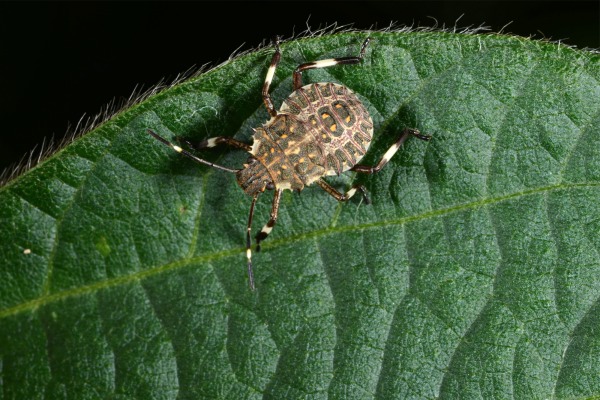
- Brown marmorated stink bugs has bit appetites for apples, cayenne pappers, bean, tomatoes and more. Photo courtesy John Obermeyer/Purdue University
For the past month, I’ve been consumed with brown marmorated stink bugs. I’ve repurposed newspapers into swatting machines, killing more than 100 on the outside of my house and 10 inside on my screened-in porch.
I’m pretty observant in my garden and I did not notice any of these Asian invaders last year. So, in my world, it’s gone from zero to hundreds of mini-shielded, cilantro-stinking bugs in a year.
After online research and interviewing experts about the brown marmorated stink bug, called BMSB for short, I know the worst is yet to come. Our homes will be inundated by these bugs, and so will our tomatoes, green beans, corn, apples and just about everything else in the garden. In the next 10 years, we could be talking billions. (I wrote about this insect in The Indianapolis Star, Oct. 8.)
The BMSB (Halyomorpha halys) is not harmful to people or pets, but it emits an unpleasant, cilantro-like smell when disturbed. And, although a nuisance because the bugs want to winter in our homes, it’s a much more serious pest for gardeners and farmers. The brown marmorated stink bug nymphs and adults are equally damaging to crops, said John Obermeyer, a Purdue University entomologist.

Nymph of brown marmorated stink bug. Photo courtesy John Obermeyer/Purdue University
We can caulk our windows and doors and make sure to plug any cracks or crevices where you can see daylight in our homes. In the garden, though, protection is more challenging. Scientists are frantically trying to find a way to control this destructive pest, but right now there are no natural enemies.
Trap crops, row covers and lure traps help, but there’s still a lot that’s not known. Lure traps (Rescue is one brand), armed with pheromones, are quite effective at capturing nymphs and adults within a 30-foot range. They are usually left up from spring through fall to trap as many of the insects as possible.
If you see BMSBs, your county extension office wants to hear from you.
Resources:
Indiana map where BMSB have been found
U.S. map where BMSB have been found
All about BMSB from the Entomological Society of America/Rutgers University
